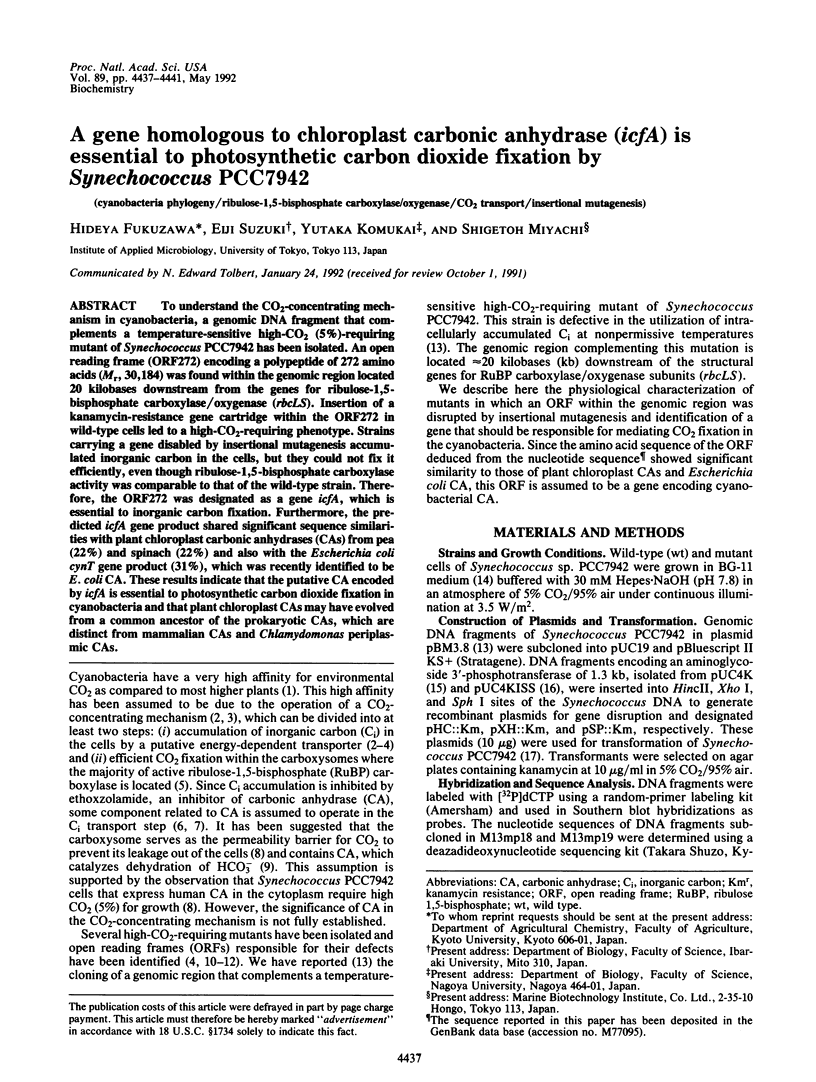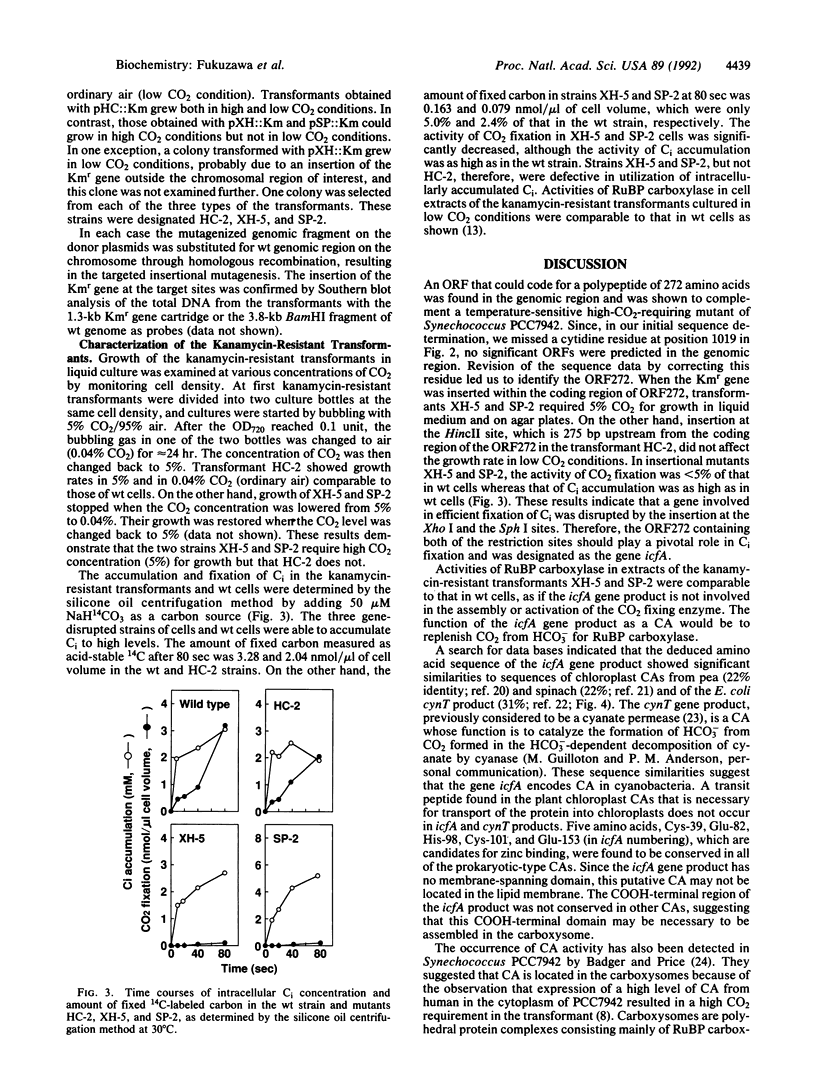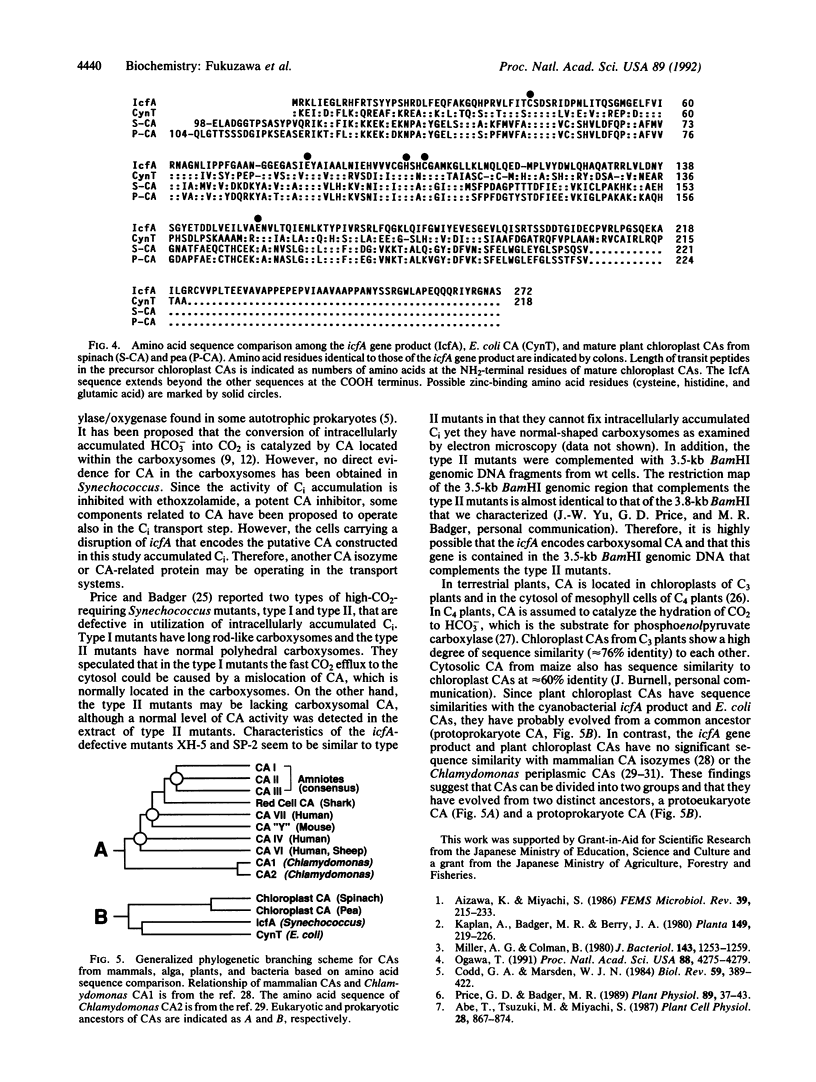Abstract
To understand the CO2-concentrating mechanism in cyanobacteria, a genomic DNA fragment that complements a temperature-sensitive high-CO2 (5%)-requiring mutant of Synechococcus PCC7942 has been isolated. An open reading frame (ORF272) encoding a polypeptide of 272 amino acids (Mr, 30,184) was found within the genomic region located 20 kilobases downstream from the genes for ribulose-1,5-bisphosphate carboxylase/oxygenase (rbcLS). Insertion of a kanamycin-resistance gene cartridge within the ORF272 in wild-type cells led to a high-CO2-requiring phenotype. Strains carrying a gene disabled by insertional mutagenesis accumulated inorganic carbon in the cells, but they could not fix it efficiently, even though ribulose-1,5-bisphosphate carboxylase activity was comparable to that of the wild-type strain. Therefore, the ORF272 was designated as a gene icfA, which is essential to inorganic carbon fixation. Furthermore, the predicted icfA gene product shared significant sequence similarities with plant chloroplast carbonic anhydrases (CAs) from pea (22%) and spinach (22%) and also with the Escherichia coli cynT gene product (31%), which was recently identified to be E. coli CA. These results indicate that the putative CA encoded by icfA is essential to photosynthetic carbon dioxide fixation in cyanobacteria and that plant chloroplast CAs may have evolved from a common ancestor of the prokaryotic CAs, which are distinct from mammalian CAs and Chlamydomonas periplasmic CAs.
Full text
PDF




Selected References
These references are in PubMed. This may not be the complete list of references from this article.
- Badger M. R., Price G. D. Carbonic Anhydrase Activity Associated with the Cyanobacterium Synechococcus PCC7942. Plant Physiol. 1989 Jan;89(1):51–60. doi: 10.1104/pp.89.1.51. [DOI] [PMC free article] [PubMed] [Google Scholar]
- Barany F. Single-stranded hexameric linkers: a system for in-phase insertion mutagenesis and protein engineering. Gene. 1985;37(1-3):111–123. doi: 10.1016/0378-1119(85)90263-x. [DOI] [PubMed] [Google Scholar]
- Burnell J. N., Hatch M. D. Low bundle sheath carbonic anhydrase is apparently essential for effective c(4) pathway operation. Plant Physiol. 1988 Apr;86(4):1252–1256. doi: 10.1104/pp.86.4.1252. [DOI] [PMC free article] [PubMed] [Google Scholar]
- Fawcett T. W., Browse J. A., Volokita M., Bartlett S. G. Spinach carbonic anhydrase primary structure deduced from the sequence of a cDNA clone. J Biol Chem. 1990 Apr 5;265(10):5414–5417. [PubMed] [Google Scholar]
- Friedberg D., Kaplan A., Ariel R., Kessel M., Seijffers J. The 5'-flanking region of the gene encoding the large subunit of ribulose-1,5-bisphosphate carboxylase/oxygenase is crucial for growth of the cyanobacterium Synechococcus sp. strain PCC 7942 at the level of CO2 in air. J Bacteriol. 1989 Nov;171(11):6069–6076. doi: 10.1128/jb.171.11.6069-6076.1989. [DOI] [PMC free article] [PubMed] [Google Scholar]
- Fujiwara S., Fukuzawa H., Tachiki A., Miyachi S. Structure and differential expression of two genes encoding carbonic anhydrase in Chlamydomonas reinhardtii. Proc Natl Acad Sci U S A. 1990 Dec;87(24):9779–9783. doi: 10.1073/pnas.87.24.9779. [DOI] [PMC free article] [PubMed] [Google Scholar]
- Fukuzawa H., Fujiwara S., Tachiki A., Miyachi S. Nucleotide sequences of two genes CAH1 and CAH2 which encode carbonic anhydrase polypeptides in Chlamydomonas reinhardtii. Nucleic Acids Res. 1990 Nov 11;18(21):6441–6442. doi: 10.1093/nar/18.21.6441. [DOI] [PMC free article] [PubMed] [Google Scholar]
- Fukuzawa H., Fujiwara S., Yamamoto Y., Dionisio-Sese M. L., Miyachi S. cDNA cloning, sequence, and expression of carbonic anhydrase in Chlamydomonas reinhardtii: regulation by environmental CO2 concentration. Proc Natl Acad Sci U S A. 1990 Jun;87(11):4383–4387. doi: 10.1073/pnas.87.11.4383. [DOI] [PMC free article] [PubMed] [Google Scholar]
- Golden S. S., Brusslan J., Haselkorn R. Genetic engineering of the cyanobacterial chromosome. Methods Enzymol. 1987;153:215–231. doi: 10.1016/0076-6879(87)53055-5. [DOI] [PubMed] [Google Scholar]
- Hatch M. D., Burnell J. N. Carbonic anhydrase activity in leaves and its role in the first step of c(4) photosynthesis. Plant Physiol. 1990 Jun;93(2):825–828. doi: 10.1104/pp.93.2.825. [DOI] [PMC free article] [PubMed] [Google Scholar]
- Hein J. Unified approach to alignment and phylogenies. Methods Enzymol. 1990;183:626–645. doi: 10.1016/0076-6879(90)83041-7. [DOI] [PubMed] [Google Scholar]
- Miller A. G., Colman B. Active transport and accumulation of bicarbonate by a unicellular cyanobacterium. J Bacteriol. 1980 Sep;143(3):1253–1259. doi: 10.1128/jb.143.3.1253-1259.1980. [DOI] [PMC free article] [PubMed] [Google Scholar]
- Ogawa T. A gene homologous to the subunit-2 gene of NADH dehydrogenase is essential to inorganic carbon transport of Synechocystis PCC6803. Proc Natl Acad Sci U S A. 1991 May 15;88(10):4275–4279. doi: 10.1073/pnas.88.10.4275. [DOI] [PMC free article] [PubMed] [Google Scholar]
- Ogawa T. Cloning and Inactivation of a Gene Essential to Inorganic Carbon Transport of Synechocystis PCC6803. Plant Physiol. 1991 May;96(1):280–284. doi: 10.1104/pp.96.1.280. [DOI] [PMC free article] [PubMed] [Google Scholar]
- Price G. D., Badger M. R. Ethoxyzolamide Inhibition of CO(2) Uptake in the Cyanobacterium Synechococcus PCC7942 without Apparent Inhibition of Internal Carbonic Anhydrase Activity. Plant Physiol. 1989 Jan;89(1):37–43. doi: 10.1104/pp.89.1.37. [DOI] [PMC free article] [PubMed] [Google Scholar]
- Price G. D., Badger M. R. Expression of Human Carbonic Anhydrase in the Cyanobacterium Synechococcus PCC7942 Creates a High CO(2)-Requiring Phenotype : Evidence for a Central Role for Carboxysomes in the CO(2) Concentrating Mechanism. Plant Physiol. 1989 Oct;91(2):505–513. doi: 10.1104/pp.91.2.505. [DOI] [PMC free article] [PubMed] [Google Scholar]
- Price G. D., Badger M. R. Isolation and Characterization of High CO(2)-Requiring-Mutants of the Cyanobacterium Synechococcus PCC7942 : Two Phenotypes that Accumulate Inorganic Carbon but Are Apparently Unable to Generate CO(2) within the Carboxysome. Plant Physiol. 1989 Oct;91(2):514–525. doi: 10.1104/pp.91.2.514. [DOI] [PMC free article] [PubMed] [Google Scholar]
- Roeske C. A., Ogren W. L. Nucleotide sequence of pea cDNA encoding chloroplast carbonic anhydrase. Nucleic Acids Res. 1990 Jun 11;18(11):3413–3413. doi: 10.1093/nar/18.11.3413. [DOI] [PMC free article] [PubMed] [Google Scholar]
- Sung Y. C., Fuchs J. A. Characterization of the cyn operon in Escherichia coli K12. J Biol Chem. 1988 Oct 15;263(29):14769–14775. [PubMed] [Google Scholar]
- Sung Y. C., Fuchs J. A. Identification and characterization of a cyanate permease in Escherichia coli K-12. J Bacteriol. 1989 Sep;171(9):4674–4678. doi: 10.1128/jb.171.9.4674-4678.1989. [DOI] [PMC free article] [PubMed] [Google Scholar]
- Suzuki E., Fukuzawa H., Miyachi S. Identification of a genomic region that complements a temperature-sensitive, high CO2-requiring mutant of the cyanobacterium, Synechococcus sp. PCC7942. Mol Gen Genet. 1991 May;226(3):401–408. doi: 10.1007/BF00260652. [DOI] [PubMed] [Google Scholar]
- Vieira J., Messing J. The pUC plasmids, an M13mp7-derived system for insertion mutagenesis and sequencing with synthetic universal primers. Gene. 1982 Oct;19(3):259–268. doi: 10.1016/0378-1119(82)90015-4. [DOI] [PubMed] [Google Scholar]


